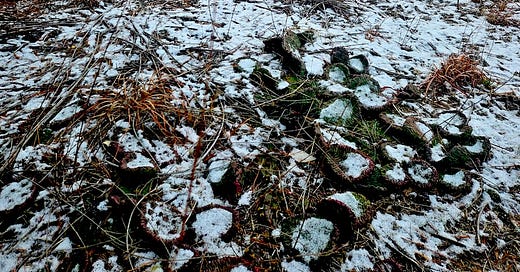When fresh untrammeled snow blankets the ground, it makes the land resemble the still surface of an enormous body of water covered in soft mist. There is also beauty in snow marked with tracks and prints and trails, if you take the time to read them. A well-traveled bed of snow becomes a palimpsest: a manuscript written many times over by the feet and shoes and paws of living things. If “palimpsest” is too obscure for you, think of it as nature’s Etch-a-Sketch.
I attended the late Tom Brown’s Tracker School in the Pine Barrens, and one of the lessons he taught was that every track is a story. And everything is a track: a pawprint in the soil; a leaf bent by a passing creature; a blade of grass shorn by the sharp teeth of a tiny rodent. It is up to us to follow these tracks like words, a stream of consciousness that tells a tale.
Living on the intracoastal plain, I often see prints in the sandy soil. I’ve found beaver tracks leaving Timber Creek, the fine fingers of a raccoon waddling as it looked for an evening snack, and chipmunk prints, right after their owner scampered into the leaf litter. The chipmunk left a complicated dance step of prints for me to read, as they waltzed around the pine needles looking for seeds. Sand makes tracking easier, but so does snow. And snow is magical, because it reveals stories that have been there all along, passing unnoticed.
My friend Suzanne, who I join on long walks some Sunday mornings, spotted a red fox trotting along the path towards us one Sunday morning. The fox saw us as well, and altered their direction towards cover. Despite seeing the fox cut into the snow-mottled grass, it took a while for us to find its prints among the dog-walkers’. A fox walks in a direct register, as do most felines, which means they place their rear paws in the same place their front paws were a moment before. Like cats, foxes also keep their claws retracted so they aren’t dulled, but they have an ovoid print, like canines, unlike cats, which have a round one. (So do some domestic dogs, but they are easy to exclude because of the large size and clawmarks.)
Once we found the fox, we tracked the prints backward for nearly a mile, losing them when the snow was clear or flattened into ice, and picking up the trail again in the fresh snow. I showed Suzanne how the “crumbs” inside a track can indicate freshness; the tiny snow crystals haven’t had time to melt in the sun, be blown by breezes, and so on. We followed the fox’s story as they trod a familiar trail criss-crossed with squirrel and rabbit tracks leading to “runs” through the grass and brush that such prey animals use for cover. Without the snow, we would have had to be well-trained trackers to see a single print at all, but the secret story was revealed to us.
Once you think this way, you can read stories others will not stop to see. Some have been lucky enough to see the imprint in the snow of an owl landing on its prey, but not all stories are so dramatic. The scatter of a thousand bird feet beneath an empty feeder as they look for scraps; a mountain bike tire track with dog prints beside it, following joyfully, the bounding prints of a squirrel planting its big rear feet ahead of its small front ones, as it digs up an old cache. Bird tracks in the snow remind me of how much time these little fliers spend on the ground. It feels like whenever I’m looking, they are high in a tree.
Maybe I need to start walking like a fox.1
I’ve changed the name of this newsletter to Fox at Timber Creek, because I plan on focusing on nature from now on. The title is meant to honor Annie Dillard and her book Pilgrim at Tinker Creek, which inspired me to look more closely at the natural world, many years ago. I’ve felt kinship with foxes from a young age, and it still horrifies me that people with too much money dress up to murder them on horseback.2
While I trudged through the snow at Timber Creek yesterday, I admired the perseverance of a large flock of Canadian Geese as they bedded down on the ice. Their feet have no blood vessels, but they must still be cold. I took shelter in the woods from the wind, and my hands were numb in my gloves. But out there, any foxes or other predators would have to skitter on the ice to reach them. There’s a spot in the swamp with running water that hasn’t frozen over, and Northern Shoveler ducks were diving to nibble weeds, showing their butts. A couple of Hooded Mergansers were there as well, splashing and preening. It reminded me that I considered joining a Polar Plunge for charity this year.
I’ll send them a check and stay warm. Speaking of resilience, here’s a Prickly Pear Cactus growing through asphalt, in the snow.
Tom Brown Jr called one of his steps the “fox walk,” because you walk in a direct register, rolling along the outer edge of your sole to soften it. When I remember to do it, I can get a lot closer to birds.
They need an appointment with the guillotine, but there’s a long line.





So cool to be able to follow a fox's footprints.
I learned a lot reading this, Thomas. You must feel one with nature when you’re out on your quiet adventures. I really appreciate you sharing your observational skills with us.